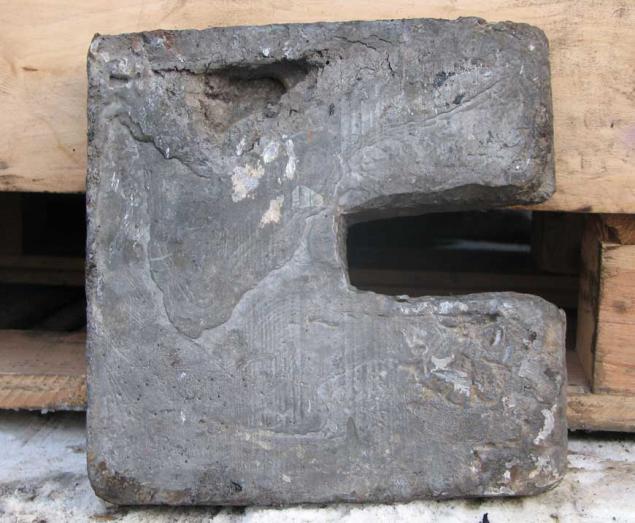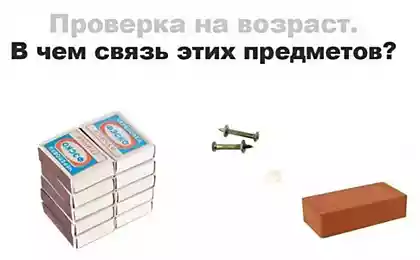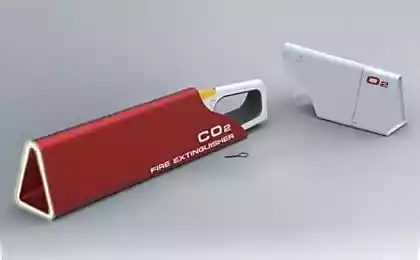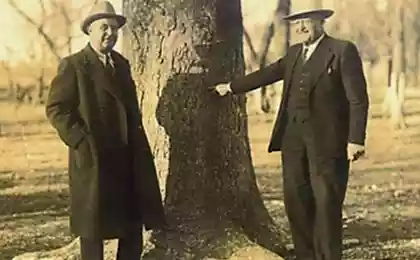512
How poisoned with lead
So. Constantly meet stories about allegedly harmful insanely newspapers: do not cut herring, fat is not wrapped, do not wipe your ass.
And to blame the lead, because sort of terribly bad.
I stumbled tonight sweetie here and has decided to write, even though PL knows.
Little did he tell you where the house is found and what is to be feared. Can anyone come in handy.
P.S. All terms and unintelligible words can google
1. Where it is not
Lead paint in a newspaper.
Of lead plates and flatbed machines used up to a maximum of WWII. Then came the era of offset and rotary machines. For conventional cheap black / white paint consists of newspapers from a mineral oil and carbon black (black pigment). Other color pigments, respectively, from different suppliers its composition, but also nifiga not lead (Printers ay, more detail can tell if there is a desire ...)
Well, where there is still a lot of course, also can finish then themselves.

2 Where it can be
Paints
Red lead and white lead.
White - paint for good coverage (ie, you can cover up in a single layer and will not shine), and as a filler in paint color (Brighter will).
Surik - here is more complicated. The powder is bright orange. It is used as anticorrosive ("Paint the red lead" probably met) as a pigment in plastics and rubber (added to the mixture, or melt), in the manufacture of crystal and glass (there is probably harmless in all).
Well, lead compounds give gloss and gloss paints
Plastic windows and other products made from PVC profiles.
Lead compounds as a stabilizer, and zinc may be, but such lead-less. And in general, PVC is still a lot of interesting (Profile Manufacturers can also comment below ...). Here and so everything is clear.
Gasoline
Tetraethyl - cheap additive to increase the octane rating of gasoline. Tetraethyl added to the gasoline in an amount of 0, 1% to improve its octane motor fuel by the combustion is emitted. It can be easily incorporated into the soil and contaminate foods. In this Europe uses your other supplements, but we all live in Russia. 3 How to poison
Breathe - the main cause of poisoning, and breathe all, chtoo characteristic, constantly and continuously. Inhalation of lead-containing dust, smoke and fumes: ie This gasoline soot; dust from the old / new paint (eg repair, peeled old paint from time to time); selection of lead in the process of heating, burning, melting (plastics, rubber, PVC); substance abuse (here all at once, you can breathe for a month).
Eat - the second leading cause. Do not eat or harvest mushrooms, berries, hay, pine cones (underline) at a distance of 100 meters from the road (Why cm. Above) and grandmothers, too, it is better not to take, will be quieter. Try to drink bottled water and / or use filters, to defend, to freeze the water. I explain the same tetraethyl plus fashionable PVC and PE water supply and wastewater treatment systems are mainly detained only mechanical particles, plus disinfection with chlorine, dissolved salts of heavy metals safely pass through the cleaning system of the mountains. plumbing. Children, children are pulled into the mouth, so once again, do not eat, drink, low-quality toys with which the paint is flaking not nibble. During until recalled after child crayons and "Masha" is also sure to wash your hands lead there certainly is. 4 As it happens
You should know and remember that the main risk group are children from 1 to 5 years. This is due to the fact that the child's body absorbs up to 40% absorbed by the lead, while the adult organism - from 5 to 10%. Maximum permissible weekly intake of lead in humans is 3 mg. This is based on the toxicity data for adults and on the assumption that only 10% absorbed received dietary lead. The set value does not apply to infants and small children because they do not known the extent of the negative impact of lead on this age group. MPC lead in the air as well as for the mercury to be 0, 003 mg / cc. m. It is proved that the increase of lead content in water makes usually increase its concentration in blood. Currently, as the hygienic standards approved by the maximum permissible concentration (MPC) of lead in drinking water at 0, 03 mg / l. Intake of insoluble but inhalants lead occurs through the lungs, and soluble - through the mucous membrane of the digestive tract and skin of excretion from the body - through the digestive tract and the kidney, the high lead content in the urine (greater than 0, 05 mg / l) is one of the indicators of lead poisoning. 5 Symptoms
Acute poisoning is accompanied by headache, weakness, dizziness, vomiting, bradycardia, sweating, salivation, itching, tremor of the extremities. Symptoms often develop 6-48 hours after exposure.
Inhalation more pronounced neurological symptoms: insomnia, headache, ataxia (incoordination), seizures, hallucinations, agitation.
When taken orally (by mouth) - dyspeptic disorders: thirst, belching, abdominal pain, nausea, vomiting, diarrhea. Children within 1-5 days - persistent uncontrollable vomiting, ataxia, seizures, impaired consciousness.
In chronic poisoning, mild to moderate intoxication, may cause myalgia (pain in the muscles), arthralgia (joint pain), paraesthesia (unusual sensation of numbness of the skin, "pins and needles" that occurs without any external influence or under the influence of some mechanical factors (compression nerves, vessels), tremor of limbs, fatigue, irritability, memory disorders, insomnia.
Discomfort in the abdomen, vomiting, weight loss, muscle wasting may develop kidney failure.
In severe intoxication (acute or chronic) arises nutritional syndrome - anorexia, taste of metal (for chronic intoxication - the feeling of hair) in the mouth, constipation, intestinal cramps, muscle tension of the abdominal wall (sometimes) on the gums - lead (blue-black) border .
Neuromuscular Syndrome (usually adult): painless peripheral neuritis and weakness of the extensor muscles. Cerebral syndrome.
In chronic poisoning - Lead encephalopathy (more children) with epileptiform seizures, coma; long-term residual effects, including neurological defects, psychiatric disorders (persistent headaches, insomnia, irritability, restless sleep with nightmares), mental retardation (in children).
In acute poisoning - hallucinations, delusions, agitation, mania, convulsions.
Posted in [mergetime] 1310237112 [/ mergetime]
6 treatment and prognosis
In acute and severe poisoning - hospitalization poison control center, in other cases - outpatients. Treatment expressed psychopathological disorders is carried out in a psychiatric hospital. Full recovery is only possible when light intoxication.
When lead encephalopathy: 25% - death, at 15-40% - persistent neurological disorders (cramps, central paralysis, atrophy of the optic nerve, mental retardation, mental retardation (in children), epileptiform seizures), possible total loss of ability to work.
The development of CKD (chronic kidney disease), gout - prolonged contact with lead.
Posted in [mergetime] 1310237171 [/ mergetime]
Whew, well, sort of all. I hope someone come in handy. And once again I remind you take care of children, they are much more fragile than we
Source:
And to blame the lead, because sort of terribly bad.
I stumbled tonight sweetie here and has decided to write, even though PL knows.
Little did he tell you where the house is found and what is to be feared. Can anyone come in handy.
P.S. All terms and unintelligible words can google
1. Where it is not
Lead paint in a newspaper.
Of lead plates and flatbed machines used up to a maximum of WWII. Then came the era of offset and rotary machines. For conventional cheap black / white paint consists of newspapers from a mineral oil and carbon black (black pigment). Other color pigments, respectively, from different suppliers its composition, but also nifiga not lead (Printers ay, more detail can tell if there is a desire ...)
Well, where there is still a lot of course, also can finish then themselves.

2 Where it can be
Paints
Red lead and white lead.
White - paint for good coverage (ie, you can cover up in a single layer and will not shine), and as a filler in paint color (Brighter will).
Surik - here is more complicated. The powder is bright orange. It is used as anticorrosive ("Paint the red lead" probably met) as a pigment in plastics and rubber (added to the mixture, or melt), in the manufacture of crystal and glass (there is probably harmless in all).
Well, lead compounds give gloss and gloss paints
Plastic windows and other products made from PVC profiles.
Lead compounds as a stabilizer, and zinc may be, but such lead-less. And in general, PVC is still a lot of interesting (Profile Manufacturers can also comment below ...). Here and so everything is clear.
Gasoline
Tetraethyl - cheap additive to increase the octane rating of gasoline. Tetraethyl added to the gasoline in an amount of 0, 1% to improve its octane motor fuel by the combustion is emitted. It can be easily incorporated into the soil and contaminate foods. In this Europe uses your other supplements, but we all live in Russia. 3 How to poison
Breathe - the main cause of poisoning, and breathe all, chtoo characteristic, constantly and continuously. Inhalation of lead-containing dust, smoke and fumes: ie This gasoline soot; dust from the old / new paint (eg repair, peeled old paint from time to time); selection of lead in the process of heating, burning, melting (plastics, rubber, PVC); substance abuse (here all at once, you can breathe for a month).
Eat - the second leading cause. Do not eat or harvest mushrooms, berries, hay, pine cones (underline) at a distance of 100 meters from the road (Why cm. Above) and grandmothers, too, it is better not to take, will be quieter. Try to drink bottled water and / or use filters, to defend, to freeze the water. I explain the same tetraethyl plus fashionable PVC and PE water supply and wastewater treatment systems are mainly detained only mechanical particles, plus disinfection with chlorine, dissolved salts of heavy metals safely pass through the cleaning system of the mountains. plumbing. Children, children are pulled into the mouth, so once again, do not eat, drink, low-quality toys with which the paint is flaking not nibble. During until recalled after child crayons and "Masha" is also sure to wash your hands lead there certainly is. 4 As it happens
You should know and remember that the main risk group are children from 1 to 5 years. This is due to the fact that the child's body absorbs up to 40% absorbed by the lead, while the adult organism - from 5 to 10%. Maximum permissible weekly intake of lead in humans is 3 mg. This is based on the toxicity data for adults and on the assumption that only 10% absorbed received dietary lead. The set value does not apply to infants and small children because they do not known the extent of the negative impact of lead on this age group. MPC lead in the air as well as for the mercury to be 0, 003 mg / cc. m. It is proved that the increase of lead content in water makes usually increase its concentration in blood. Currently, as the hygienic standards approved by the maximum permissible concentration (MPC) of lead in drinking water at 0, 03 mg / l. Intake of insoluble but inhalants lead occurs through the lungs, and soluble - through the mucous membrane of the digestive tract and skin of excretion from the body - through the digestive tract and the kidney, the high lead content in the urine (greater than 0, 05 mg / l) is one of the indicators of lead poisoning. 5 Symptoms
Acute poisoning is accompanied by headache, weakness, dizziness, vomiting, bradycardia, sweating, salivation, itching, tremor of the extremities. Symptoms often develop 6-48 hours after exposure.
Inhalation more pronounced neurological symptoms: insomnia, headache, ataxia (incoordination), seizures, hallucinations, agitation.
When taken orally (by mouth) - dyspeptic disorders: thirst, belching, abdominal pain, nausea, vomiting, diarrhea. Children within 1-5 days - persistent uncontrollable vomiting, ataxia, seizures, impaired consciousness.
In chronic poisoning, mild to moderate intoxication, may cause myalgia (pain in the muscles), arthralgia (joint pain), paraesthesia (unusual sensation of numbness of the skin, "pins and needles" that occurs without any external influence or under the influence of some mechanical factors (compression nerves, vessels), tremor of limbs, fatigue, irritability, memory disorders, insomnia.
Discomfort in the abdomen, vomiting, weight loss, muscle wasting may develop kidney failure.
In severe intoxication (acute or chronic) arises nutritional syndrome - anorexia, taste of metal (for chronic intoxication - the feeling of hair) in the mouth, constipation, intestinal cramps, muscle tension of the abdominal wall (sometimes) on the gums - lead (blue-black) border .
Neuromuscular Syndrome (usually adult): painless peripheral neuritis and weakness of the extensor muscles. Cerebral syndrome.
In chronic poisoning - Lead encephalopathy (more children) with epileptiform seizures, coma; long-term residual effects, including neurological defects, psychiatric disorders (persistent headaches, insomnia, irritability, restless sleep with nightmares), mental retardation (in children).
In acute poisoning - hallucinations, delusions, agitation, mania, convulsions.
Posted in [mergetime] 1310237112 [/ mergetime]
6 treatment and prognosis
In acute and severe poisoning - hospitalization poison control center, in other cases - outpatients. Treatment expressed psychopathological disorders is carried out in a psychiatric hospital. Full recovery is only possible when light intoxication.
When lead encephalopathy: 25% - death, at 15-40% - persistent neurological disorders (cramps, central paralysis, atrophy of the optic nerve, mental retardation, mental retardation (in children), epileptiform seizures), possible total loss of ability to work.
The development of CKD (chronic kidney disease), gout - prolonged contact with lead.
Posted in [mergetime] 1310237171 [/ mergetime]
Whew, well, sort of all. I hope someone come in handy. And once again I remind you take care of children, they are much more fragile than we
Source:























